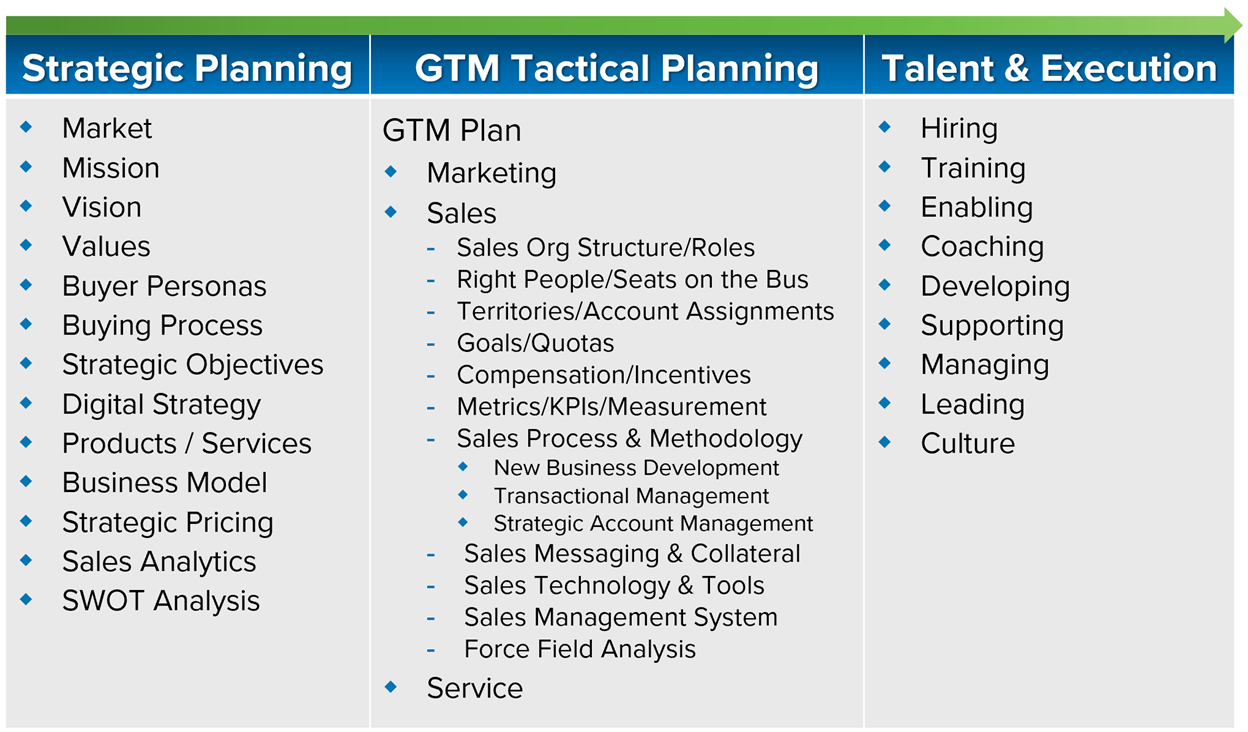Buyer Acumen is the Best GTM Foundation
13.5 minutes

Luca D’Urbino
Would you build your 3-story dream home on a foundation of mud and straw?
I’m guessing that your answer is, “No, Mike, I wouldn’t. That would be reckless and stupid.” And I’d agree with you.
Yet, this is what I see happening in many businesses with their GTM strategies and tactical plans, when they do not intentionally build their businesses and strategies on a rock-solid foundation of Buyer Acumen.
The Flow of Strategy, Tactics, and Execution
I often use the below chart (Figure 1) in my work with clients
Figure 1: Strategy, Tactics, Execution Chart

[Click the image or this link for a larger graphic]
- Quick sidebar/disclaimer: In my work, I usually focus on the sales function more than marketing or service/customer success, so I don’t have the detail listed under those functions in this specific graphic. To be clear, that detail is equally important, and I do recommend alignment and cross-functional collaboration between functions, for maximum success. I include the functions here purposefully to indicate that.
The point of the chart is this: The work on the left is a prerequisite for the work to the right of it and must be completed to some level of proficiency for your organization to reach maximum effectiveness. The top-to-bottom flow is not as strict in all cases, and is more situationally-dependent. But, in some cases, the work on the top may be a prerequisite for the work below it, as well. If you use the chart, be attuned to that, and use your best judgment.
Now, that said, does everything need to be perfect? No, of course not, although I won’t argue against excellence, at a minimum. But in many real-world cases, depending on the maturity of the organization and other situational factors, sometimes a GEFN state (Good Enough For Now) will suffice, assuming there is an plan for measurement, continuous improvement, and pivots, based on progress or changing market factors.
How does this all relate to Buyer Acumen? In the Strategic Planning column in the chart, the Market, Buyer Personas, and Buying Process bullets are all part of the larger concept of Buyer Acumen. Let’s further define the term.
So, What Exactly Is Buyer Acumen?
In my book, The Building Blocks of Sales Enablement, I define Buyer Acumen as a deep understanding of your buyers and customers (for simplicity here, I’ll just call them “buyers”). This includes:
- Their role and goals
- The buyer personas or buyer profiles
- Their COIN-OP: This is an acronym that we teach in Modern Sales Foundations which means the Challenges they face, the Opportunities they can capitalize on, the Impacts (positive or negative) of those challenges and/or opportunities, the Needs their situation creates, their desired Outcomes, and the Priorities of those needs and outcomes)
- Metrics: How are they measured in their company? What are the “metrics that matter most” to them, and how do they and their leaders define success in their role?
- Budgets: What are their typical budgets, their span of control, and their purchasing authority?
- Buying process: What is their typical buyer’s journey? Who do they interact with internally during it? What are the most common decision criteria? How do your buyers make their decisions?
- Company size: If it applies, in what size company or verticals do they typically work? (If this matters, it will help further define your Ideal Customer Profile or ICP)
- Other pressures: What other risks, pressures, preferences, or internal politics might influence your buyers?
- Personal factors: What emotional or other personal factors or personal needs might be in play?
- Value creation: How do they define “value?” Is it Business Value (financial and operational metrics), Aspirational Value (aligned with mission, vision, values, or critical issues such as DEI or sustainability), Experiential Value (improvement of process or experience, such as employee, candidate, and customer experience), and/or personal value (something that matters to them as an individual, such as reducing risk, looking good, increasing political capital, a sense of accomplishment, etc.), or a mix?
That’s a great start, already, but let’s examine buying process even further.
Buying Process with Exit Criteria
Every process has stages, objectives, tasks, and exit criteria. Exit criteria is a term from various disciplines, including Six Sigma, software development, and business process management (BPM). It refers to the things that you need to complete in a process stage before moving forward. So, when applied to the buying process, exit criteria are the things that each buyer needs to see, hear, feel, understand, and believe in each stage of their purchase pursuit, before they’ll feel comfortable moving forward to the next step or stage, with you. Salespeople have their own exit criteria per stage, in their sales process, but one of their exit criteria should always be to uncover, clarify, satisfy, and confirm the satisfaction of all decision makers’ exit criteria.
Knowing this, you should expand your persona and Buyer Acumen research to include a typical buying process and the buying process exit criteria for each persona in each stage (in some stages, exit criteria may be the same; in others, they may vary). This also gives you an opportunity to align your sales process to the buying process.
So, how do you determine how your buyers make purchase decisions? Think about these questions:
- Who do they typically collaborate with, internally, as they make purchase decisions for products and services like yours?
- If they have a defined process, what is it? Whenever possible, I prefer to document the entire customer lifecycle (which the includes the buying process as one part), but at a minimum, start with the buying process.
- What are their overall decision criteria, and what are their buying process exit criteria at each stage of their process?
Figure 2: Buying/Sales Process Example (Consultative Sale for a Buy & Implement Solution)

[Click the image or this link for a larger graphic with sales methodology added]
Once you know the buying journey that most of your prospects traverse, you can align your sales process to support it. Not to minimize other aspects of process alignment (this is important work and often missing or done poorly with an inside-out perspective rather than outside-in), but I usually place the most emphasis on preparing to support the buying process exit criteria for your buyers.
This is the central task in opportunity management and a key lever for performance improvement. If you understand your buyers’ exit criteria for each process stage, it eliminates “selling by superstition.” This allows reps to focus on precisely what matters, delivering just what the buyer needs and wants, when they need and want it.
Just as with personas, exit criteria can be documented generally, but when selling, they must be discovered and understood for each real buyer on the decision team. While I don’t always refer to this as “qualification,” it is an ongoing form of it. It’s an understanding of the detailed criteria in each stage for each buyer. If you can’t meet these criteria, it dramatically reduces your chance of winning the opportunity. While there are a myriad of qualification methods available, whichever you use, you must include this to reach maximum effectiveness.
Buyer Acumen gives organization leaders and especially your sales force the foundational information needed to foster Awareness, generate Interest, and develop Relationships (deals need AIR to breathe). B2B buying research continually points to the customer’s desire to feel understood (and, unfortunately, how buyers feel that the average sales reps fall short in this regard). Demonstrating this understanding and personalizing your messaging and sales conversations accordingly is a vital tenet of credibility and trust, especially when reps do so without discussing their solution until they fully understand the problem and know they have NASA or Need And Solution Alignment (which is why I consider patience to be a superpower of selling).
Why Buyer Acumen is the Foundation You Need
While the above should be plenty to convince you, let’s take it one step further. There are so many good metaphors here: foundations, spider webs, tentacles, dot connections, dominoes, the critical path in project management, and more. Whichever you like, the bottom-line is this:
“If you get Buyer Acumen right, everything else that
follows will work better, run more smoothly,
and be more effective.”
If you get Buyer Acumen wrong, so many of your downstream activities and dependencies will be far less effective (or rendered completely ineffective).
Buyer Acumen Dot Connections
If you understand the personas who are involved in a buying decision, their COIN-OP, their buying process, and the buying process exit criteria for each persona, you can:
- Create marketing content that will be a magnet for your personas and generate enough interest to engage (inbound/content marketing).
- Inform the outbound prospecting efforts for your SDRs or AE hunters to improve their lead generation.
- Provide the right collateral during both prospecting and the buying process that will satisfy your various buyers’ exit criteria at each stage, giving them the information and insight that they need to continue their journey with you and eventually make an informed purchase decision.
- Support your sellers’ sales methodology (especially early-stage like prospecting and the beginning stages of opportunity management) by providing insights into the various roles and what matters most to them.
- Note: sellers, once they begin to get past personas and work with the people in the roles, need to validate any persona assumptions, conduct a full situation assessment (deep discovery), and work to uncover, clarify, and satisfy their buyers’ real buying process exit criteria.
- Upgrade your sales onboarding and ongoing training, to ensure your sellers are as well-informed about your buyers and decision makers as they are about their products and services.
- Anticipate common concerns and prepare materials and your salespeople to address and resolve those concerns
- Learn to personalize both marketing and sales messaging based on the personas and people, and what they value most.
These are just some of the downstream impacts (positive or negative) of getting Buyer Acumen right (or not). As you work to develop the most effective GTM strategies and tactics for 2022 and beyond, consider the strength of your Buyer Acumen, and whether you need to dig and pour a new foundation, just fix a few cracks, or focus on the other areas of your plan, because your Buyer Acumen is already rock solid. Whichever you need to do, get this work right, do the follow-on marketing work with content, and train, coach, and support your sales team appropriately and watch your sales effectiveness increase.

